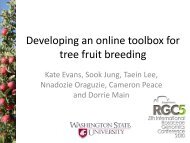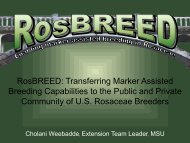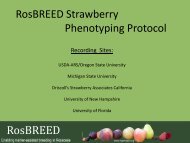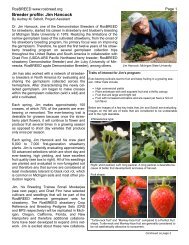Breeder profile: Nnadozie Oraguzie - RosBREED
Breeder profile: Nnadozie Oraguzie - RosBREED
Breeder profile: Nnadozie Oraguzie - RosBREED
Create successful ePaper yourself
Turn your PDF publications into a flip-book with our unique Google optimized e-Paper software.
www.<strong>RosBREED</strong>.org<br />
<strong>Breeder</strong> <strong>profile</strong>: <strong>Nnadozie</strong> <strong>Oraguzie</strong><br />
By Audrey M. Sebolt, Project Assistant<br />
<strong>Nnadozie</strong> <strong>Oraguzie</strong>, Washington State University<br />
Figure 1: Range of skin colors from yellow to dark red that are<br />
sought after by the Washington State University sweet cherry<br />
breeding program<br />
Figure 2: Nnandozie’s research technician, Blessing Athanson,<br />
measures titratable acidity.<br />
If you have ever eaten the sweet cherry ‘Rainier’, a fruit<br />
whose delicate flavor sings with sweetness and whose<br />
cheeks have been kissed red by the sun, then you have<br />
eaten a cultivar that was developed and released in 1952<br />
by Washington State University’s breeder Dr. Harold<br />
Fogle. ‘Rainier’ has the highest valued fruit of any sweet<br />
cherry cultivar produced in the Pacific Northwest (PNW).<br />
In the years following… Sweet cherry progeny, generated<br />
by Dr. Tom Toyama (Dr. Fogle’s successor) were released<br />
as new cultivars by a series of researchers, primarily<br />
to help spread the harvest window.<br />
Fast forward many years... With support from the PNW<br />
sweet cherry industry, the Washington State University<br />
sweet cherry breeding program was revived in 2004.<br />
Start-up funding was provided by the Washington Tree<br />
Fruit Research Commission and Oregon Sweet Cherry<br />
Commission. Dr. Amy Iezzoni, Michigan State University’s<br />
tart cherry breeder, was hired as a consultant for the<br />
program because of her extensive knowledge of cherry<br />
genetics and collection of European cherry germplasm<br />
(for more information, see <strong>RosBREED</strong>’s “<strong>Breeder</strong> Profile”:<br />
Amy Iezzoni). She was asked to initiate crosses leading<br />
to new sweet cherry cultivars that would increase the varietal<br />
options (Figure 1) for PNW sweet cherry growers.<br />
After initial populations were established, Dr. <strong>Nnadozie</strong><br />
<strong>Oraguzie</strong> was hired in 2008 as the full-time breeder for<br />
the PNW sweet cherry breeding program. <strong>Nnadozie</strong> had<br />
previously been an apple breeder at HortResearch in<br />
New Zealand for 10 years.<br />
Stage I – generating plant materials. <strong>Nnadozie</strong> focused<br />
on designing crosses based on the phenotypes of parents<br />
and a working knowledge of trait heritabilities. <strong>Nnadozie</strong><br />
would make about 60 crosses each spring, which<br />
would yield 2000-5000 seeds. Once these seedlings produced<br />
fruit, three to five years after the initial cross, his<br />
program would evaluate these seedlings for several<br />
years. Once a promising seedling was found, he would<br />
propagate it for advanced trials. Unfortunately, a high proportion<br />
of seedlings would be self-infertile and/or produce<br />
small fruit; this wasted resources spent on those inferior<br />
plants.<br />
Increased fruit size is an economically valuable trait because<br />
±2 mm in diameter can mean the difference between<br />
profit and loss for growers; therefore, discovering<br />
loci for increased fruit size is critical. If a self-fertile parent,<br />
which contains only one self-fertile allele, is crossed<br />
to a self-infertile parent, then usually half of the seedlings<br />
are self-fertile. Determining which seedlings are selffertile<br />
in the field can take several years. New self-fertile<br />
cultivars are valuable to the PNW industry because they<br />
would not require a compatible pollinizer nor bees to<br />
achieve adequate fruit set. Often pollinizers are considered<br />
lost production revenue because they produce inferior<br />
fruit or require separate cultural and harvest regimes.
Stage II – increasing breeding efficiency through adoption of marker-assisted breeding. <strong>Nnadozie</strong>’s program was one of<br />
Box A: Traits that <strong>Nnadozie</strong> selects for according to type and genetic<br />
test availability.<br />
Current M-L-T Future M-L-Ts Additional Traits<br />
Self-fertility Late bloom time Sufficient yielding<br />
Fruit flavor: acidity<br />
and sugar<br />
Fruit quality: size<br />
and firmness<br />
Ripening dates – early<br />
and late season<br />
Freestone<br />
Fruit appearance: skin<br />
and flesh color<br />
Low cracking incidence<br />
Disease resistance:<br />
powdery mildew<br />
Fruit doubling<br />
Consistent fruit production<br />
performance<br />
Disease resistance: bacterial<br />
canker<br />
Pedicle retention force –<br />
stems remain attached to<br />
fruit after mechanical harvesting<br />
(or stem-less)<br />
Skin pitting: skin is not damaged<br />
after fruit is harvested,<br />
sorted and/or packaged<br />
the first <strong>RosBREED</strong> Demonstration Breeding programs<br />
to adopt the Marker-Assisted Breeding (MAB)<br />
Pipeline, developed by Dr. Cameron Peace<br />
(Washington State University). In 2008, <strong>Nnadozie</strong><br />
and Cameron began to fast-track the WSU seedlings<br />
for <strong>RosBREED</strong>’s “jewels” (critical sweet cherry<br />
traits). These traits already had genetic markers associated<br />
with them and include increased fruit size,<br />
firmness (<strong>RosBREED</strong>’s “Jewels in the Genome”:<br />
Sweet cherry fruit size and firmness) and flavor<br />
(acidity and sugar; Figure 1), and self-fertility<br />
(<strong>RosBREED</strong>’s “Jewels in the Genome”: Cherry selfincompatibility);<br />
for information about how to apply<br />
this “jewel”, see the Community <strong>Breeder</strong>s’ Page in<br />
this Newsletter. In the last two years, almost 3000<br />
seedlings have been screened by Cameron’s Pacific<br />
Northwest Tree Fruit Genotyping Lab in Pullman for<br />
these genetic tests. More than half of the seedlings<br />
have been culled and the remaining seedlings planted,<br />
the net future savings (by avoiding land use fees<br />
and tree maintenance and evaluation costs) is estimated<br />
at more than $75,000.<br />
For <strong>RosBREED</strong>, <strong>Nnadozie</strong> has provided a total of<br />
240 seedlings and cultivars for the Sweet Cherry<br />
Crop Reference Set and another 240 for his Breeding Pedigree Set, to well represent the genomes of important breeding<br />
parents in his program. This germplasm has already been screened for two “jewels” (genetic tests for fruit size and acidity)<br />
via the “fast-tracked pipelining” approach and genome-scanned using the International <strong>RosBREED</strong> SNP Consortium<br />
cherry 6K SNP array. The genome scan data will be analyzed with two years of field data for ~15 traits, which is expected<br />
to result in the discovery of many new “jewels” for sweet cherry (Box A).<br />
While <strong>Nnadozie</strong> appreciates the focus of <strong>RosBREED</strong> on fruit quality traits, as these are of highest priority to his program,<br />
he also hopes that before graduation, his PhD student Murali Bellamkonda (see below) will have found markers to identify<br />
seedlings that are resistant to powdery mildew and bloom later in the spring. <strong>Nnadozie</strong> feels that marker-assisted<br />
breeding is efficient because of the shining jewels already available and used in his program, and the systematic Pipeline<br />
that Cameron has developed for polishing new jewels. <strong>Nnadozie</strong> is also excited to utilize the <strong>Breeder</strong>’s Toolbox that<br />
<strong>RosBREED</strong> developed; next spring he hopes to use the Toolbox for cross planning!<br />
Meet <strong>Nnadozie</strong>’s Breeding Trainee: Murali Bellamkonda<br />
Why did you choose <strong>Nnadozie</strong> <strong>Oraguzie</strong>’s program? I joined Dr.<br />
<strong>Nnadozie</strong> <strong>Oraguzie</strong>’s sweet cherry breeding program because Washington<br />
State University is a world-class institution when it comes to<br />
plant sciences and <strong>Nnadozie</strong> is an experienced fruit breeder with multinational<br />
exposure and expertise. I am very much grateful to him for<br />
introducing me into this beautiful world of Rosaceae fruit breeding and<br />
associating me with this gigantic <strong>RosBREED</strong> project.<br />
What is your thesis project? For my thesis project, I am working on<br />
the genetic control of bloom time, harvest date, fruit firmness and powdery<br />
mildew disease resistance.<br />
What benefits have you seen by being part of <strong>RosBREED</strong>? There<br />
are many advantages to being a part of <strong>RosBREED</strong>: first of all, I have<br />
Murali Bellamkonda, Washington State University<br />
been participating and getting training in all aspects of the breeding<br />
program. <strong>RosBREED</strong> gave me the opportunity of understanding all<br />
phases of marker-assisted breeding techniques in sweet cherry. I have also gained experience in Pedigree-Based Analysis<br />
through annual <strong>RosBREED</strong> Workshops and would like to have the same experience for high-throughput SNP marker<br />
data analysis. Finally, I get the opportunity of meeting with several people with expertise in different disciplines and<br />
from different institutions across the USA.








